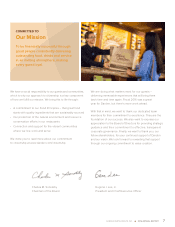Red Lobster 2016 Annual Report Download - page 21
Download and view the complete annual report
Please find page 21 of the 2016 Red Lobster annual report below. You can navigate through the pages in the report by either clicking on the pages listed below, or by using the keyword search tool below to find specific information within the annual report.
MANAGEMENT’S DISCUSSION AND ANALYSIS
OF FINANCIAL CONDITION AND RESULTS OF OPERATIONS
DARDEN
DARDEN RESTAURANTS, INC. • 2016 ANNUAL REPORT 17
Unearned Revenues
Unearned revenues represent our liability for gift cards that have been sold
but not yet redeemed. The estimated value of gift cards expected to remain
unused is recognized over the expected period of redemption as the remaining
gift card values are redeemed, generally over a period of 10 years. Utilizing
this method, we estimate both the amount of breakage and the time period
of redemption. If actual redemption patterns vary from our estimates, actual
gift card breakage income may differ from the amounts recorded. We update
our estimates of our redemption period and our breakage rate periodically
and apply that rate to gift card redemptions. Changing our breakage-rate
assumption on unredeemed gift cards by 25 basis points would result in an
adjustment in our unearned revenues of approximately $19.0 million.
Income Taxes
We estimate certain components of our provision for income taxes. These
estimates include, among other items, depreciation and amortization
expense allowable for tax purposes, allowable tax credits for items such as
taxes paid on reported employee tip income, effective rates for state and
local income taxes and the tax deductibility of certain other items. We adjust
our annual effective income tax rate as additional information on outcomes
or events becomes available.
Assessment of uncertain tax positions requires judgments relating to
the amounts, timing and likelihood of resolution. As described in Note 13
to our consolidated financial statements, the $14.3 million balance of
unrecognized tax benefits at May 29, 2016, includes $1.2 million related to
tax positions for which it is reasonably possible that the total amounts could
change during the next 12 months based on the outcome of examinations.
The $1.2 million relates to items that would impact our effective income
tax rate.
LIQUIDITY AND CAPITAL RESOURCES
Cash flows generated from operating activities are our principal source of
liquidity, which we use to finance capital expenditures for new restaurants
and to remodel existing restaurants, to pay dividends to our shareholders
and to repurchase shares of our common stock. Since substantially all of our
sales are for cash and cash equivalents, and accounts payable are generally
due in 5 to 30 days, we are able to carry current liabilities in excess of current
assets. In addition to cash flows from operations, we use a combination of
long-term and short-term borrowings to fund our capital needs.
We currently manage our business and financial ratios to target an
investment-grade bond rating, which has historically allowed flexible access
to financing at reasonable costs. Currently, our publicly issued long-term
debt carries “Baa3” (Moody’s Investors Service), “BBB” (Standard & Poor’s)
and “BBB” (Fitch) ratings. Our commercial paper has ratings of “P-3”
(Moody’s Investors Service), “A-2” (Standard & Poor’s) and “F-2” (Fitch).
These ratings are as of the date of the filing of this annual report and have
been obtained with the understanding that Moody’s Investors Service,
Standard & Poor’s and Fitch will continue to monitor our credit and make
future adjustments to these ratings to the extent warranted. The ratings are
not a recommendation to buy, sell or hold our securities, may be changed,
superseded or withdrawn at any time and should be evaluated independently
of any other rating.
During fiscal 2015, we conducted a comprehensive evaluation of a
wide range of options for the potential monetization of our real estate portfolio.
As a result of this evaluation, we undertook the following strategies:
• Sale-leaseback transactions of 64 restaurant properties, 14 of
which closed in the fourth quarter of fiscal 2015 and the remaining
50 transactions closed in fiscal 2016. The 64 transactions generated
net proceeds of $238.0 million.
• Transfer of 424 of our restaurant properties into a REIT, with substan-
tially all of the REIT’s initial assets being leased back to Darden.
We completed the spin-off of Four Corners on November 9, 2015.
See Note 2 to our consolidated financial statements for further details.
• Sale-leaseback of our corporate headquarters, which was completed
in fiscal 2016, generating net proceeds of $131.0 million.
We maintain a $750.0 million revolving Credit Agreement (Revolving
Credit Agreement), with Bank of America, N.A. (BOA) as administrative agent,
and the lenders and other agents party thereto. The Revolving Credit
Agreement is a senior unsecured credit commitment to the Company and
contains customary representations and affirmative and negative covenants
(including limitations on liens and subsidiary debt and a maximum consoli-
dated lease adjusted total debt to total capitalization ratio of 0.75 to 1.00)
and events of default usual for credit facilities of this type. As of May 29,
2016, we were in compliance with all covenants under the Revolving
Credit Agreement.
The Revolving Credit Agreement matures on October 24, 2018, and
the proceeds may be used for commercial paper back-up, working capital
and capital expenditures, the refinancing of certain indebtedness, certain
acquisitions and general corporate purposes. Loans under the Revolving
Credit Agreement bear interest at a rate of LIBOR plus a margin determined
by reference to a ratings-based pricing grid (Applicable Margin), or the base
rate (which is defined as the highest of the BOA prime rate, the Federal
Funds rate plus 0.500 percent, and the Eurocurrency Rate plus 1.00 percent)
plus the Applicable Margin. Assuming a “BBB” equivalent credit rating
level, the Applicable Margin under the Revolving Credit Agreement will be
1.100 percent for LIBOR loans and 0.100 percent for base rate loans.
As of May 29, 2016, we had no outstanding balances under the Revolving
Credit Agreement.
At May 29, 2016, our long-term debt consisted principally of:
• $150.0 million of unsecured 6.000 percent senior notes due in
August 2035; and
• $300.0 million of unsecured 6.800 percent senior notes due in
October 2037.
























